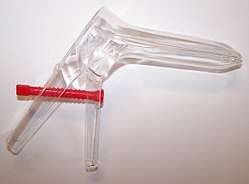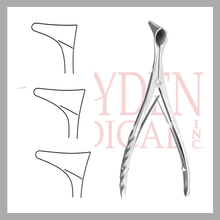Speculum (medical)
A speculum (Latin for "mirror"; plural specula or speculums), is a medical tool for investigating body orifices, with a form dependent on the orifice for which it is designed. In old texts, the speculum may also be referred to as a diopter or dioptra.[1] Like an endoscope, a speculum allows a view inside the body; endoscopes, however, tend to have optics while a speculum is intended for direct vision.

History

Vaginal and anal specula were used by the ancient Greeks and Romans,[2] and speculum artifacts have been found in Pompeii.[3] A vaginal speculum, developed by J. Marion Sims, consists of a hollow cylinder with a rounded end that is divided into two hinged parts, somewhat like the beak of a duck. The speculum is inserted into the vagina to dilate it for examination of the vagina and cervix.
Construction
Specula were formerly made of stainless steel, and sterilized after use. However, many, especially those used in emergency departments and doctor's offices, are now made of plastic, and are disposable, single-use items. Those used in surgical suites are still commonly made of metal.
Types

Specula come in a variety of shapes based on their purpose, and a variety of sizes;[4] in any case the cylinder or blade(s) of the instrument allow the operator a direct vision of the area of interest and the possibility to introduce instruments for further interventions such as a biopsy.
Vaginal use
The best-known speculum is the bivalved vaginal speculum; the two blades are hinged and are "closed" when the speculum is inserted to facilitate its entry and "opened" in its final position where they can be arrested by a screw mechanism, so that the operator is freed from keeping the blades apart.
A cylindrical-shaped speculum, introduced in 2001, the dilating vaginal speculum (also known as the Veda-scope[5]) invented by Clemens van der Weegen,[6] inflates the vagina with filtered air.[7] (see diagram) The device has two main functions: a) to take a normal Pap smear with a cervical brush or a cytology brush; and b) as an internal colposcope so that the operator can pivot the Veda-scope to view any part of the vagina barrel and cervix facilitated by an internal light source that can illuminate the vaginal wall and cervix with multi-coloured light filters, which can detect pre-cancerous cells with the aid of acetic acid solution and iodine solution. It also has a facility to attach a digital camera for viewing and recording.[8]

A specialized form of vaginal speculum is the weighted speculum, which consists of a broad half tube which is bent at about a 90 degree angle, with the channel of the tube on the exterior side of the angle. One end of the tube has a roughly spherical metal weight surrounding the channel of the speculum. A weighted speculum is placed in the vagina during vaginal surgery with the patient in the lithotomy position. The weight holds the speculum in place and frees the surgeon's hands for other tasks. A vaginal speculum is also used in fertility treatments, particularly artificial insemination, and allows the vaginal cavity to be opened and observed thereby facilitating the deposit of semen into the vagina.
- Cylindrical shape
- Ferguson
- Glass speculum
- Veda-scope (dilating vaginal speculum)
- One blade

|
|
- Two blades (bivalved)


|
|
- Three blades
|
|
Rectal use
Vaginal specula are also used for anal surgery, although several other forms of anal specula exist. One form, the anoscope, resembles a tube that has a removable bullet-shaped insert. When the anoscope is inserted into the anus, the insert dilates the anus to the diameter of the tube. The insert is then removed, leaving the tube to allow examination of the lower rectum and anus.
This style of anal speculum is one of the oldest designs for surgical instruments still in use, with examples dating back many centuries. The sigmoidoscope can be further advanced into the lower intestinal tract and requires an endoscopic set-up.
- Tubal shape
- Aniscope
- One blade
- Czerny
- Two blades
|
|
- Three blades
- Alan Park
- Cook
- Mathieu
Nasal use


Nasal specula have two relatively flat blades with handle. The instrument is hinged so that when the handles are squeezed together the blades spread laterally, allowing examination.
|
|
Additionally, the Thudichum nasal speculum is commonly used in the outpatient examination of the nose.
Aural use

Ear or aural specula resemble a funnel, and come in a variety of sizes.
|
Oral use
In veterinary medicine, a McPherson Speculum can be used for oral examination. The speculum helps keep the mouth open during the exam and helps avoid biting injuries.
BDSM
Speculums may be used recreationally by BDSM practitioners during sexual encounters.[9]
See also
- Endoscope
- Colposcope
- Vaginal dilator
References
| Wikimedia Commons has media related to speculums. |
- "diopter" in The Compact Edition of the Oxford English Dictionary, Oxford University Press, 1971
- Univ. of Virginia. "Surgical Instruments from Ancient Rome (with pictures)". Retrieved 2009-06-12.
- Cecilia Mettler. History of Medicine. The Blakiston Co (1947).
- "Comparison chart of speculum types, with line images". Retrieved 2014-05-03.
- Longmore, P. G. (2004). "Veda-scope: More comfortable than the bivalve speculum and cytologically equivalent". The Australian and New Zealand Journal of Obstetrics and Gynaecology. 44 (2): 140–5. doi:10.1111/j.1479-828X.2004.00180.x. PMID 15089838.
- van der Weegen, Clemens (2000) "Vaginal speculum with seal" U.S. Patent 6,719,687
- Thomas, A; Weisberg, E; Lieberman, D; Fraser, I. S. (2001). "A randomised controlled trial comparing a dilating vaginal speculum with a conventional bivalve speculum". The Australian & New Zealand journal of obstetrics & gynaecology. 41 (4): 379–86. PMID 11787909.
- How it works. pacificei.com
- Speculum Play by www.kinkly.com